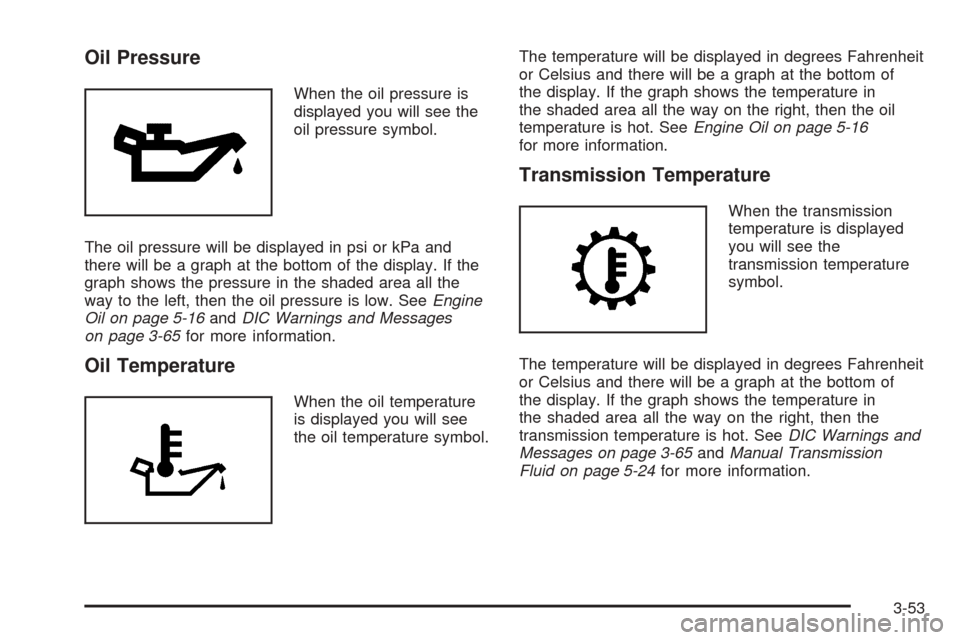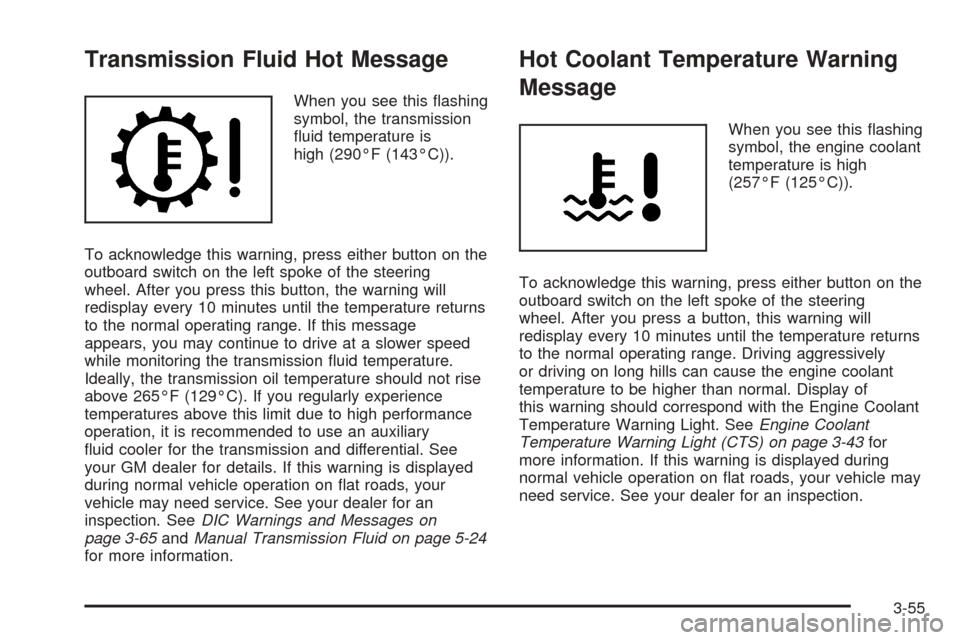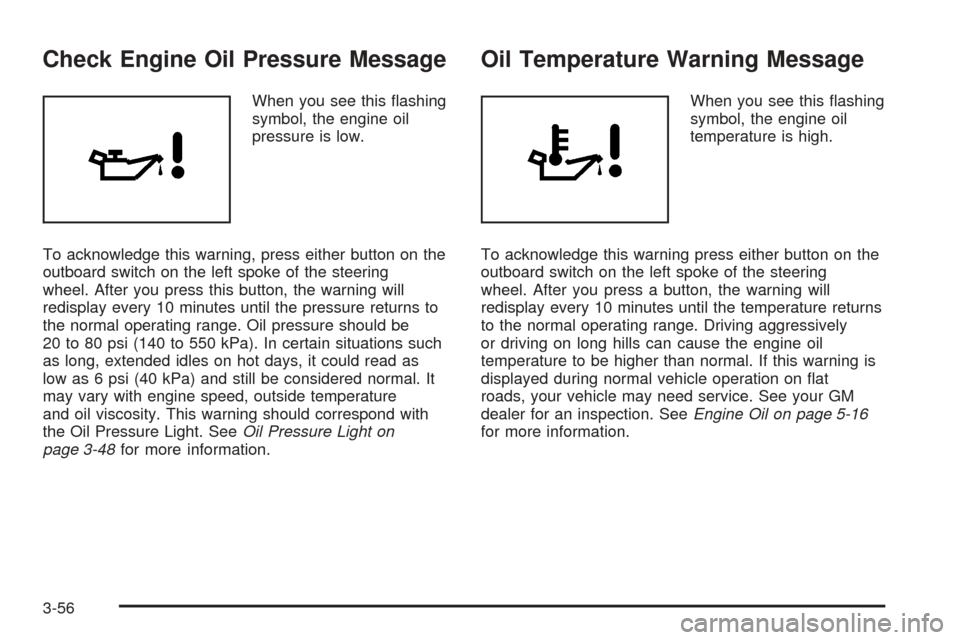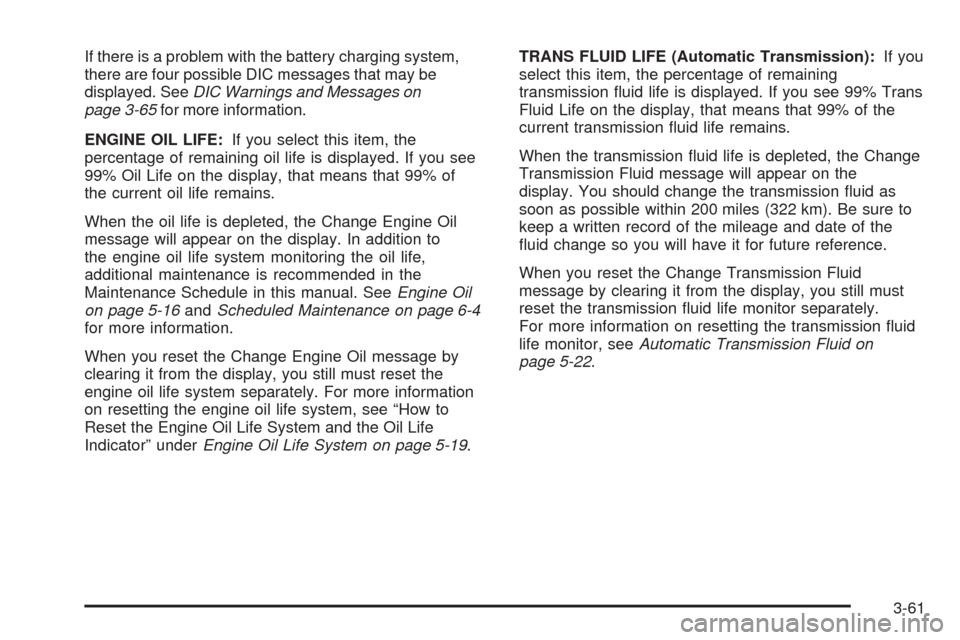warning CADILLAC CTS V 2005 1.G Owner's Manual
[x] Cancel search | Manufacturer: CADILLAC, Model Year: 2005, Model line: CTS V, Model: CADILLAC CTS V 2005 1.GPages: 432, PDF Size: 2.52 MB
Page 176 of 432

Cruise Control Light
This light comes on
whenever you set your
cruise control.
The light will go out when the cruise control is turned
off. SeeCruise Control (CTS) on page 3-12or
Cruise Control (CTS-V) on page 3-16for more
information.
Highbeam On Light
This light comes on
whenever the high-beam
headlamps are on.
SeeHeadlamp High/Low-Beam Changer on page 3-9
for more information.
Fuel Gage
The fuel gage shows
approximately how much
fuel is in the tank. It
works only when the
ignition is in ON.
If the fuel supply gets low, the Fuel Level Low message
will appear on the DIC and a single chime will sound.
SeeDIC Warnings and Messages on page 3-65
for more information.
3-50
Page 177 of 432

Here are a few concerns some owners have had about
the fuel gage. All of these situations are normal and
do not indicate that anything is wrong with the fuel gage:
At the gas station the gas pump shuts off before
the gage reads full.
The gage may change when you turn, stop quickly
or accelerate quickly.
It takes a little more or less fuel to �ll the tank than
the gage indicated. For example, the gage may
have indicated that the tank was half full, but
it actually took a little more or less than half the
tank’s capacity to �ll the tank.
Message Center
Message Center (CTS-V)
Your vehicle may have a message center that can
display information relating to powertrain �uids,
tire pressures, vehicle dynamics, speedometer and
odometer information, and transmission status. It also
displays warning messages. There are two different
areas where message center information will be
displayed. One display is inside of the tachometer and
the other is inside of the speedometer.These are the controls
for the message center.
They are located on
the left spoke of the
steering wheel.
The outboard switch (A and B) controls the display of
information inside of the tachometer. The upper
button (C) on the inboard switch controls the display of
information inside of the speedometer. The lower
button (D) on the inboard switch turns the traction
control on or off. SeeTraction Control System (TCS)
(CTS) on page 4-8orTraction Control System
(TCS) (CTS-V) on page 4-9for more information.
3-51
Page 179 of 432

Oil Pressure
When the oil pressure is
displayed you will see the
oil pressure symbol.
The oil pressure will be displayed in psi or kPa and
there will be a graph at the bottom of the display. If the
graph shows the pressure in the shaded area all the
way to the left, then the oil pressure is low. SeeEngine
Oil on page 5-16andDIC Warnings and Messages
on page 3-65for more information.
Oil Temperature
When the oil temperature
is displayed you will see
the oil temperature symbol.The temperature will be displayed in degrees Fahrenheit
or Celsius and there will be a graph at the bottom of
the display. If the graph shows the temperature in
the shaded area all the way on the right, then the oil
temperature is hot. SeeEngine Oil on page 5-16
for more information.
Transmission Temperature
When the transmission
temperature is displayed
you will see the
transmission temperature
symbol.
The temperature will be displayed in degrees Fahrenheit
or Celsius and there will be a graph at the bottom of
the display. If the graph shows the temperature in
the shaded area all the way on the right, then the
transmission temperature is hot. SeeDIC Warnings and
Messages on page 3-65andManual Transmission
Fluid on page 5-24for more information.
3-53
Page 180 of 432

Tire Pressure
When the tire pressure is displayed you will see a
vehicle in the display. The numbers in each corner
represent the tire pressure for the corresponding tire.
The tire pressure will be displayed in psi or kPa.
If any of the tires are blinking on the vehicle in the
display, this means that the tire pressure in that tire is
either high or low. SeeTire Pressure Monitor System
(CTS-V) on page 5-65for more information.
Lateral Acceleration
Lateral acceleration is a measure of how hard you are
taking a corner. For example, when you are turning right
you will feel your body push to the left. This force is
measured in a “g”. This gage will display from 0.00 g to
1.2 g. The lowest reading means there is no lateral
acceleration. The highest reading means the force the
driver is feeling is 1.2 times the acceleration due
to gravity.
When (B) is pressed and held while the Lateral
Acceleration display is being shown, the peak hold
values—both tick marks and numbers—will be reset
to zero.
Warning Messages
The warning messages that are described in the
following text are also shown in the tachometer display.
While any warning messages are shown, pressing
(A) or (B) will acknowledge the warning and then display
the gage relating to the error message. For instance,
if a tire is below the minimum recommended pressure,
the tire pressure warning message will blink on and
off (5 times for a low tire warning, continuously for a �at
tire warning). The driver can go to the tire pressure
display immediately by pressing either button on
the outboard switch.
3-54
Page 181 of 432

Transmission Fluid Hot Message
When you see this �ashing
symbol, the transmission
�uid temperature is
high (290°F (143°C)).
To acknowledge this warning, press either button on the
outboard switch on the left spoke of the steering
wheel. After you press this button, the warning will
redisplay every 10 minutes until the temperature returns
to the normal operating range. If this message
appears, you may continue to drive at a slower speed
while monitoring the transmission �uid temperature.
Ideally, the transmission oil temperature should not rise
above 265°F (129°C). If you regularly experience
temperatures above this limit due to high performance
operation, it is recommended to use an auxiliary
�uid cooler for the transmission and differential. See
your GM dealer for details. If this warning is displayed
during normal vehicle operation on �at roads, your
vehicle may need service. See your dealer for an
inspection. SeeDIC Warnings and Messages on
page 3-65andManual Transmission Fluid on page 5-24
for more information.
Hot Coolant Temperature Warning
Message
When you see this �ashing
symbol, the engine coolant
temperature is high
(257°F (125°C)).
To acknowledge this warning, press either button on the
outboard switch on the left spoke of the steering
wheel. After you press a button, this warning will
redisplay every 10 minutes until the temperature returns
to the normal operating range. Driving aggressively
or driving on long hills can cause the engine coolant
temperature to be higher than normal. Display of
this warning should correspond with the Engine Coolant
Temperature Warning Light. SeeEngine Coolant
Temperature Warning Light (CTS) on page 3-43for
more information. If this warning is displayed during
normal vehicle operation on �at roads, your vehicle may
need service. See your dealer for an inspection.
3-55
Page 182 of 432

Check Engine Oil Pressure Message
When you see this �ashing
symbol, the engine oil
pressure is low.
To acknowledge this warning, press either button on the
outboard switch on the left spoke of the steering
wheel. After you press this button, the warning will
redisplay every 10 minutes until the pressure returns to
the normal operating range. Oil pressure should be
20 to 80 psi (140 to 550 kPa). In certain situations such
as long, extended idles on hot days, it could read as
low as 6 psi (40 kPa) and still be considered normal. It
may vary with engine speed, outside temperature
and oil viscosity. This warning should correspond with
the Oil Pressure Light. SeeOil Pressure Light on
page 3-48for more information.
Oil Temperature Warning Message
When you see this �ashing
symbol, the engine oil
temperature is high.
To acknowledge this warning press either button on the
outboard switch on the left spoke of the steering
wheel. After you press a button, the warning will
redisplay every 10 minutes until the temperature returns
to the normal operating range. Driving aggressively
or driving on long hills can cause the engine oil
temperature to be higher than normal. If this warning is
displayed during normal vehicle operation on �at
roads, your vehicle may need service. See your GM
dealer for an inspection. SeeEngine Oil on page 5-16
for more information.
3-56
Page 183 of 432

Tire Pressure Warning Message
When you see this �ashing
symbol, one or more of the
vehicle’s tires is either
under or over-in�ated.
To acknowledge this warning, press either button on the
outboard switch on the left spoke of the steering
wheel. There are three levels of warning for this display:
1. High Tire Pressure (above 42 psi (290 kPa))
2. Low Tire Pressure (below 25 psi (170 kPa))
3. Flat Tire (below 5 psi (35 kPa))
For conditions 1 and 2, this warning will �ash �ve times
and the display will then show the tire pressure gage.
For condition 3, this warning will �ash continuously until
the driver acknowledges it. In any of the three cases,
the warning will redisplay every 10 minutes until
the situation is corrected. Conditions 2 and 3 will also
display a warning light elsewhere on the cluster that will
stay illuminated after this warning is acknowledged.
SeeTire Pressure Light (CTS-V) on page 3-44for more
information. Also seeTire Pressure Monitor System
(CTS-V) on page 5-65for more information on tire
pressure speci�cations.
Driver Information Center (DIC)
The DIC gives you the status of many of your vehicle’s
systems. It is also used to display driver personalization
features and warning/status messages. All messages
will appear on the audio system display which is also the
display for the Navigation system.
If your vehicle has the Base audio system, use the
information contained in this manual for instructions on
operating the DIC for your vehicle.
If your vehicle has the Navigation system, see the
CTS/CTS-V Navigation system manual for instructions
on operating the DIC for your vehicle.
3-57
Page 184 of 432

System Controls
Use the following controls located on the audio system
to operate the DIC:
INFO (Information):Use the up or down arrows on this
switch to scroll through the system status information.CLR (Clear):Press this button to clear DIC messages
and to reset some DIC displays to zero. This button
is also used to exit out of a menu. SeeDIC Warnings
and Messages on page 3-65andStatus of Vehicle
Systems on page 3-58for more information.
TUNE/SEL (Select) Knob:To scroll through the menu
items displayed, turn the knob, located in the lower
right corner. Press the knob to select the menu item.
Status of Vehicle Systems
You can view the status of several vehicle systems
using the DIC.
3-58
Page 186 of 432

MPG INST:If you select this item, the current fuel
economy is displayed. This number re�ects only the fuel
economy that the vehicle has right now and will change
frequently as driving conditions change. Unlike average
fuel economy, this menu item cannot be reset.
GAL FUEL USED:If you select this item, the number
of gallons or liters of fuel used since the last reset of this
menu item is displayed.
To reset GAL FUEL USED, press the CLR button
located to the right of the screen. The display will
return to zero.
MILES RANGE:If you select this item, the approximate
number of remaining miles or kilometers you can
drive without refueling is displayed. This estimate is
based on the current driving conditions and will change
if the driving conditions change. For example, if you
are driving in traffic making frequent stops, the display
may read one number, but if you enter the freeway,
the number may change even though you still have the
same amount of gas in the gas tank. This is because
different driving conditions produce different fuel
economies. Generally, freeway driving produces better
fuel economy than city driving.
If your vehicle is low on fuel, the Fuel Level Low
message will be displayed. See “Fuel Level Low” under
DIC Warnings and Messages on page 3-65for more
information.AVG MPH:If you select this item, the average speed of
the vehicle is displayed in miles per hour (mph) or
kilometers per hour (km/h). This average is calculated
based on the various vehicle speeds recorded since the
last reset of this menu item.
To reset AVG MPH, press the CLR button located to
the right of the screen. The display will return to zero.
TIMER:If you select this item, a timing feature is
displayed. The timer functions like a stopwatch in that
you can record the time it takes to travel from one point
to another.
To use the timer, you must �rst turn it on. To turn on
the timer, press the CLR button located to the right
of the screen once. The display will read
00:00:00 TIMER ON and begin counting.
Press the button again to turn the timer off. When the
timer is off, the display will show the timer value
and TIMER OFF. The timing feature will stop.
To reset the timer, turn off the timer and then press and
hold the CLR button. The display will return to zero.
BATTERY VOLTS:If you select this item, the current
battery voltage is displayed. If the voltage is in the normal
range, the display will have OK after it. For example, the
display may read 13.2 Battery Volts OK.
3-60
Page 187 of 432

If there is a problem with the battery charging system,
there are four possible DIC messages that may be
displayed. SeeDIC Warnings and Messages on
page 3-65for more information.
ENGINE OIL LIFE:If you select this item, the
percentage of remaining oil life is displayed. If you see
99% Oil Life on the display, that means that 99% of
the current oil life remains.
When the oil life is depleted, the Change Engine Oil
message will appear on the display. In addition to
the engine oil life system monitoring the oil life,
additional maintenance is recommended in the
Maintenance Schedule in this manual. SeeEngine Oil
on page 5-16andScheduled Maintenance on page 6-4
for more information.
When you reset the Change Engine Oil message by
clearing it from the display, you still must reset the
engine oil life system separately. For more information
on resetting the engine oil life system, see “How to
Reset the Engine Oil Life System and the Oil Life
Indicator” underEngine Oil Life System on page 5-19.TRANS FLUID LIFE (Automatic Transmission):If you
select this item, the percentage of remaining
transmission �uid life is displayed. If you see 99% Trans
Fluid Life on the display, that means that 99% of the
current transmission �uid life remains.
When the transmission �uid life is depleted, the Change
Transmission Fluid message will appear on the
display. You should change the transmission �uid as
soon as possible within 200 miles (322 km). Be sure to
keep a written record of the mileage and date of the
�uid change so you will have it for future reference.
When you reset the Change Transmission Fluid
message by clearing it from the display, you still must
reset the transmission �uid life monitor separately.
For more information on resetting the transmission �uid
life monitor, seeAutomatic Transmission Fluid on
page 5-22.
3-61